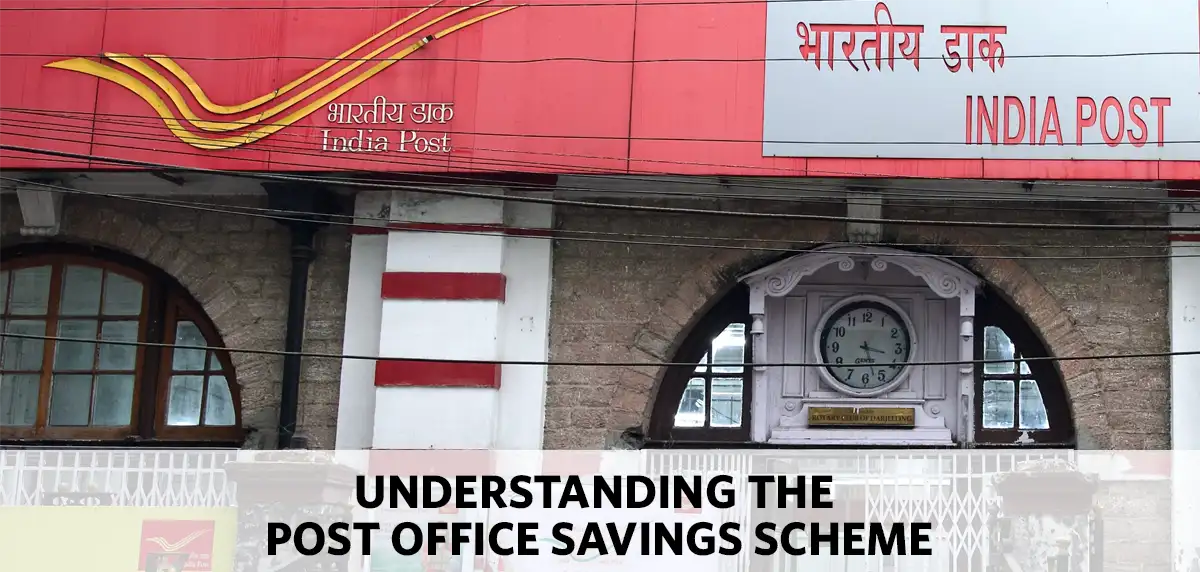The Post Office Savings Scheme has served generations of Indians as a secure and dependable avenue for conserving surplus funds. Let’s examine the features, benefits, and processes, associated with the Indian post office savings scheme. Let’s also explore related offerings - such as the Post Office Monthly Income Scheme, Post Office Fixed Deposit, the interest rates, and the different tools, such as the fixed deposit calculator.
Towards the end, a first-time investor can understand how to use postal instruments to meet personal financial goals.
Types Of Post Office Savings Accounts
Post offices offer several account types under the broader umbrella of the Post Office Savings Scheme. Each scheme serves a different need — from daily savings to long-term tax-efficient investments.
Below is an updated, concise list with purpose and key features.
1. Post Office Savings Account
- A Post Office Savings Account functions like a normal bank savings account.
- It is transferable from one post office to another.
- It is Ideal for salaried individuals and an emergency fund.
- It has a nominal minimum balance requirement — often around ₹500.
2. National Savings Monthly Income Scheme (MIS)
- The National Savings Monthly Income Scheme (MIS) requires an initial lump sum deposit.
- It pays a fixed monthly interest to the investor.
- The tenure is usually five years.
- It is well-suited to retirees or those needing a steady monthly cash flow.
3. National Savings Recurring Deposit (RD) Account
- It allows fixed monthly deposits for a chosen tenure.
- It helps small or modest-income investors build a corpus.
- A National Savings Recurring Deposit (RD) Account can be opened singly or jointly.
- It compounds interest periodically and pays out at maturity.
4. National Savings Time Deposit Account / Fixed Deposit (TDA / FD)
- A National Savings Time Deposit Account is also referred to simply as a Time Deposit Account.
- It has tenures commonly ranging from 1 to 5 years.
- When held for 5 years, it may qualify for a tax deduction under Section 80C.
- It is suitable for investors seeking a fixed return over a defined period.
5. Public Provident Fund (PPF) Account
- It is a long-term government savings scheme.
- It offers tax benefits under Section 80C and tax-free maturity proceeds.
- It has a long lock-in period, making it suitable for retirement and long-term goals.
- A Public Provident Fund (PPF) Account compounds interest annually.
6. Senior Citizen Savings Scheme (SCSS)
- It is available to residents aged 60 and above (and earlier in some special cases).
- It matures after 5 years; may be extendable by 3 years.
- A Senior Citizen Savings Scheme (SCSS) pays quarterly interest.
- It is designed for conservative investors seeking regular income and safety.
7. Kisan Vikas Patra (KVP)
- It is a one-time investment certificate that grows at a fixed rate.
- Historically, it has been structured to double the invested amount in a set period (around 9 years, 10 months, depending on the rate).
- The Kisan Vikas Patra (KVP) is suitable for investors looking for a simple, long-term capital growth instrument.
8. National Savings Certificate (NSC)
- It is a fixed-income investment certificate issued by post offices.
- The National Savings Certificate (NSC) encourages small and medium investors to save, while earning fixed returns.
- The investments typically qualify for deduction under Section 80C.
- It pays interest with maturity.
9. Sukanya Samriddhi Yojana (SSY) / Sukanya Samriddhi Account
- It is launched for the financial welfare of the girl child.
- The Sukanya Samriddhi Yojana (SSY) enables parents/guardians to build a fund for education and marriage.
- It offers attractive interest, along with tax benefits under Section 80C.
- It locks in the deposits to align with the child’s future needs.
Each scheme has distinct rules on tenure, eligibility, tax treatment and nomination. Choose the one that matches your horizon, liquidity needs and tax objectives.
Calculating Returns
Investors planning for the future should use a reliable fixed deposit calculator. Input the deposit amount, duration, and prevailing interest rate, to estimate maturity proceeds. For MIS, one may calculate monthly payouts by dividing the annual interest by 12 and applying it to the deposit.
Key Features And Benefits
Established long before most modern financial institutions, the scheme carries a legacy of trust.
1. Safety And Sovereign Guarantee
- All deposits under the Post Office Savings Scheme are backed by the Government of India.
- Credit risk remains virtually nil, making these instruments safe havens.
2. Attractive Interest Rates
- Though rates may not match riskier instruments, they remain competitive for risk-averse investors.
- Regular announcements by the Ministry of Finance ensure rates reflect economic conditions.
3. Tax Benefits**
- Interest on the Post Office Savings Scheme account is taxable as per an individual’s slab rate.
- However, schemes such as the Public Provident Fund (PPF) enjoy tax exemption.
- Individuals can plan deposits in multiple instruments to optimise tax impact.
4. Liquidity And Accessibility
- Post offices have the widest physical presence, particularly in rural India.
- With digital initiatives, account holders can now access information online, though deposit operations may often require a visit.
5. Quarterly Interest Payout
- Savings accounts credit interest every quarter.
- Other instruments, such as MIS, credit interest on a monthly basis.
- TDAs credit interest at maturity or on a quarterly basis (for tenures of 5 years).
Opening A Post Office Savings Account
Opening a post office savings account is straightforward. You can apply in person or use online channels. Below are the clear, step-by-step ways to open an account, the documents you will need, and the usual deposit and nomination rules.
Choose An Account Type
Decide whether you want a Savings Account, Recurring Deposit (RD), Time Deposit Account (TDA/FD), Monthly Income Scheme (MIS) or any other post office scheme. Choose according to your financial goal — short-term savings, regular income or long-term security.
Required Documents
Bring originals and photocopies (whenever requested):
- Proof of Identity: Aadhaar, Passport or Voter ID.
- Proof of Address: Utility bill, Ration Card or any other accepted proofs.
- PAN card (if available / for tax purposes).
- Passport-size photographs.
- Two witnesses — required for certain schemes or account types.
How To Open — By Downloading The Application Form (In-Person Submission)
Step 1. Download and print the relevant form from the Department of Posts website.
Step 2. Fill the form and attach the required documents and photographs.
Step 3. Visit your home branch (post office) and submit the application.
Step 4. Pay the minimum amount required for the chosen scheme.
Step 5. The staff at the post office will verify your documents, open the account, and issue a passbook.
How To Open — Through Internet Banking (Existing Post Office Account Holders)
Step 1. Visit the Department of Posts Internet Banking portal and choose New User Activation.
Step 2. Enter your Customer ID and Account ID (found in your passbook) and follow the activation prompts.
Step 3. Log in with your user ID and password.
Step 4. Go to General Service > Service Request > New Requests.
Step 5. Select the scheme you want to open, complete the online form and submit.
Step 6. Follow any on-screen instructions for fund transfer and verification.
How To Open — Through Mobile App
Step 1. Download the India Post Mobile Banking app from the app store.
Step 2. Log in or register as required.
Step 3. Use the Requests (or equivalent) tab to choose the scheme, enter details (deposit, tenure, nominee, source account) and submit.
Initial Deposit And Minimums
- Savings Account: Minimum opening deposit is usually ₹500.
- MIS: Requires a lump sum deposit (typically ₹1,000 and multiples).
- TDA / FD: Deposit amount depends on the chosen tenor and scheme rules.
- RD: Requires fixed monthly deposits as per the selected plan.
Check the scheme brochure or ask staff for current minimums and modes of payment.
Verification, Passbook And Activation
After submission, the post office will verify your documents. Once approved, they will open the account and provide a passbook. For internet and mobile applications, follow any verification steps and retain transaction references until you receive confirmation.
Nomination And Succession
Nomination is strongly recommended. It enables the swift transfer of funds to the nominated person on your demise. Some schemes also require witnesses for nomination or specific instruments. Always complete the nomination section while opening the account.
Interest Rate Trends
Interest rates on post office savings schemes have evolved across decades. For example, the savings account rate hovered at 4%–4.5% in recent years. However, TDAs and MIS rates frequently exceed these values by 0.5–1.0 percentage points. Consult official sources for updates while you manage your accounts.
Tax Implications**
Below is a clear, revised section on tax treatment for the main Post Office savings schemes.
TDS, Forms 15G / 15H And How Interest Is Taxed
- Interest from most post-office deposits is taxable as “Income from Other Sources” and must be declared in your ITR.
- TDS (Section 194A): Payers (including post offices) may deduct TDS on interest if the total interest credited/paid in a financial year exceeds the statutory threshold (commonly ₹40,000 or ₹50,000 for regular depositors; a higher threshold applies for senior citizens). The usual TDS rate is 10% where PAN is quoted (higher when PAN is missing).
- Form 15G / 15H: If your total taxable income is below the basic exemption limit (or you are otherwise eligible), you may submit Form 15G (below-age taxpayers) or Form 15H (senior citizens) to avoid TDS on interest. These are self-declaration forms and must be submitted before TDS is deducted.
Taxability Of Major Post Office Schemes (At A Glance)
Scheme
| Tax Treatment
|
Post Office Time Deposit (5-year TDA / Tax-saving FD)
| Principal invested in the 5-year time deposit qualifies for deduction under Section 80C (subject to the overall ₹1.5 lakh 80C limit). Interest is taxable as per your slab.
|
Post Office Monthly Income Scheme (MIS / POMIS)
| Interest is fully taxable as per your income-tax slab. TDS under Section 194A may apply when the aggregate interest in the year exceeds the threshold.
|
Senior Citizen Savings Scheme (SCSS)
| Contributions/eligible investments in SCSS are covered under Section 80C, subject to the overall ₹1.5 lakh limit (check scheme caps separately). Interest paid is taxable and may attract TDS where applicable. (See official guidance for senior-specific limits and exemptions).
|
National Savings Certificate (NSC)
| Deposits in NSC qualify for deduction under Section 80C. In addition, interest that is deemed reinvested in the first four years is also eligible under 80C (the interest element becomes taxable on maturity/receipt).
|
Sukanya Samriddhi Yojana (SSY)
| Contributions qualify for deduction under Section 80C. Interest earned in SSY is exempt from tax under the relevant provisions (i.e., maturity/interest enjoys tax benefits).
|
Public Provident Fund (PPF)
| PPF contributions qualify under Section 80C. Interest and maturity proceeds are tax-exempt (EEE status).
|
The overall Section 80C limit remains the key cap (₹1.5 lakh in recent years). Use that limit to plan which small-savings or tax-saving instruments you place priority on. If you expect no tax liability for the year, submit Form 15G/15H to the post office to prevent TDS at source. Keep a copy of the acknowledgement.
Who Should Choose The Post Office Savings Scheme?
Here are a few people a post office savings scheme could be best for:
1. Risk-Averse Investors
- Preferring guaranteed returns over market volatility.
2. Retirees
- Seeking predictable income via MIS.
- Wishing to preserve capital.
3. Rural And Semi-Urban Residents
- Lacking easy access to private banks.
- Valuing the local post office presence.
4. Parents And Guardians
- Looking to use children’s RD accounts for future education needs.
The Post Office Savings Scheme remains a cornerstone for conservative investors in India. From the simple post office savings account and the post office monthly income scheme to the national savings certificate and Sukanya Samriddhi account, it provides a variety of instruments suited to different needs. By understanding prevailing post office fixed deposit interest rates, utilising a fixed deposit calculator and weighing tax implications, investors can make informed choices. Whether saving for a child’s future or planning for retirement, the scheme’s sovereign guarantee and wide reach make it a valuable component of an overall financial strategy.
** Tax exemptions are as per applicable tax laws from time to time.





















